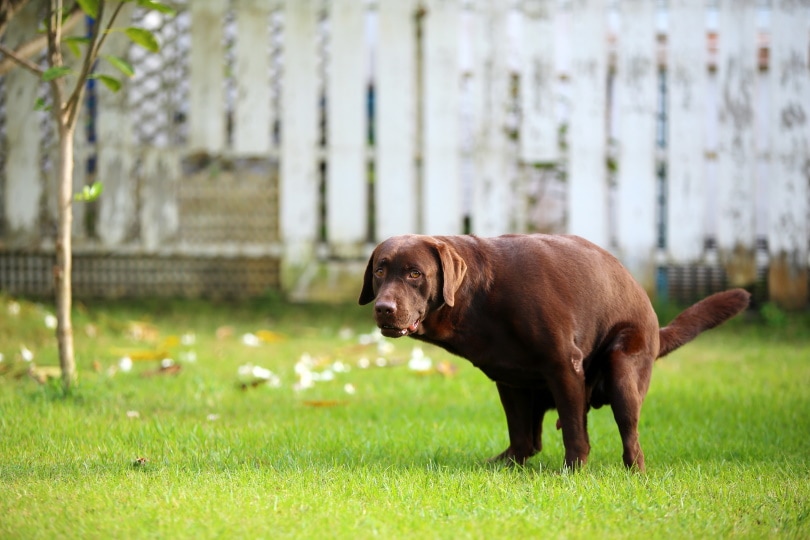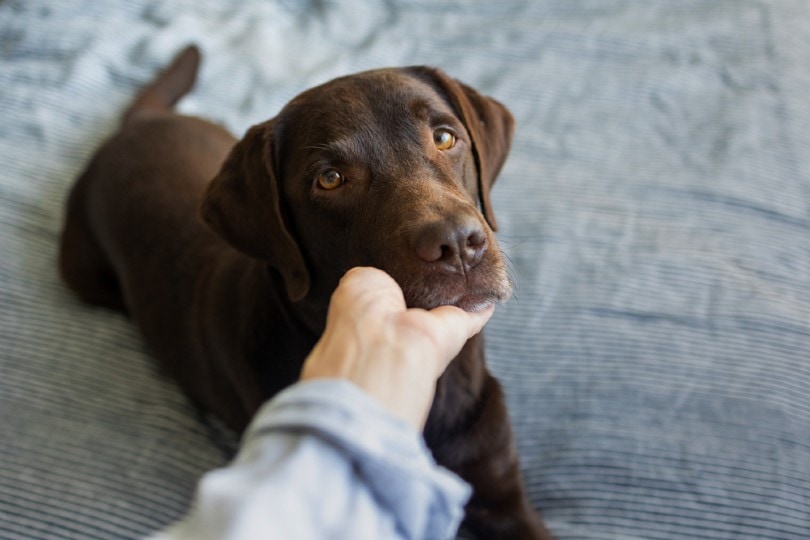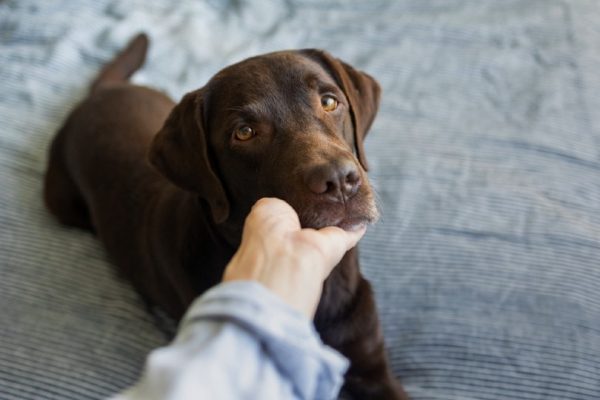Labradors are among the most popular dogs and make excellent family pets and great companions. They are always there to put a smile on your face and some peppy energy in your day. What happens when your furry friend is feeling under the weather?
There are a number of medical conditions that Labradors may experience. In this article, you can read up on the issues your pup may face and what can be done about them.
The 13 Common Labrador Health Issues
1. Luxating Patella
When a dog is suffering from a luxating patella, it has a kneecap that does not stay in the correct position. It is a common condition in most breeds, but especially in Labrador Retrievers.
When the kneecap shifts away from its proper place, it usually moves inward towards the inner side of the knee. Occasionally, the kneecap will shift outward, but that is less common.
Symptoms of a luxating patella include limping, skipping gait, standing in a bow-legged stance, hunching the lower back, or clunking sounds when the leg is bent. Sometimes, your dog may make a pained noise when the injury has occurred, but other times it may not show any discomfort.
If medical management is a viable option, your vet may temporarily restrict activity, prescribe anti-inflammatory medications, or establish a weight-loss goal if needed. They may then advise physiotherapy to strengthen the thigh muscles.
In more severe instances, surgery may be the only option. This option has potential risks and benefits, as there are with any surgical procedure.
One potential risk is that the luxating patella will return since resurgence rates can be up to 36%. Other less common problems include fractures, infections, and progressive arthritis. Based on your dog’s breed and the severity of their case, your vet will be able to explain the specific risks in more depth.

2. Distichiasis
Distichiasis occurs when an eyelash grows from an abnormal place on the eyelid. When this happens, the eyelash may contact and damage the eye, specifically the cornea or conjunctiva.
If your lab is struggling with this condition, they can experience symptoms such as constant eye rubbing, a twitching eyelid, an overflow of tears, an increase in blood vessels inside the cornea, and possibly even corneal ulcers.
Generally speaking, treatment is needed to remove the abnormally positioned eyelashes. Sometimes lubricant eye medications will be sufficient to protect the eye.
There may be a need for surgical intervention, especially if the eyelashes are causing damage or pain. Consult your vet and discuss the best possible options for its health and comfort.
3. Canine Hip Dysplasia
Canine hip dysplasia occurs during your dog’s growth stages and results in an improperly formed hip joint on one or both sides. This can lead to pain and poor operation of the joint. Eventually, it can result in other conditions, such as arthritis and muscle atrophy. Hip dysplasia is thought to be caused by a combination of genetics, nutrition, and exercise in a young dog.
Signs of hip dysplasia include limping, cracking sounds from the joints, skipping when running, struggling to stand, awkward sitting positions, and difficulty climbing stairs.
If caught early enough, the condition can be managed with medications. However, surgery may be needed for severe hip dysplasia.
The surgery can be significantly more accessible and less invasive for younger dogs. For adult dogs, it is more likely that a total hip replacement or a femoral head osteotomy will be required.

4. Osteochondritis Dissecans
When cartilage at the end of a bone is malformed during joint development, it may become diseased and tear from the bone. It is an inflammatory condition that occurs known as osteochondritis dissecans (OCD or OD). It may impact the elbow, hip, or knee, but the shoulder is the most common location.
If you think your dog may have this condition, look for signs of lameness, limping, or swelling and heat at the site of the joint.
In less severe instances, your lab will be able to heal if it rests and is restricted from activity for several weeks. Your vet can decide what level of activity your dog should have at the time. Medications may be prescribed to help with inflammation and the health of the joint, and physical therapy exercises may be recommended.
If this approach does not solve the issue, surgery may be required.
5. Exercise-Induced Collapse
It won’t be too hard to guess if your lab has suffered from exercise-induced collapse. If your pet has suddenly collapsed after a significant amount of activity or excitement, it could be the cause.
Depending on the dog, exercise-induced collapse can be a chronic issue or a random occurrence. If it has happened to your dog before, or it has not, but you think it could happen, take a look at the warning signs.
Key indications that your pup isn’t well are an unsteady or forced gait, weak rear limbs, and a lack of coordination. If these signs are ignored, your dog can collapse and experience mobility issues.
When this happens, most dogs are alert. However, some may be dazed. After the collapse, symptoms may worsen for a few minutes before recovery.
Most dogs will recover on their own in a short amount of time, up to 25 minutes. They should not be in pain during or after the recovery. If the condition persists or your dog is in pain, contact your vet.

6. Diabetes
Diabetes can affect dogs just as it affects humans. It cannot be cured, but it can be managed.
Insulin-deficiency diabetes occurs when your pup cannot create enough insulin, and insulin-resistant diabetes happens when your dog’s body cannot use the insulin as it should.
Symptoms may include extreme thirst, increased urination, weight loss, and a higher appetite. If the diabetes is advanced, other symptoms may be a loss of appetite, less energy, depression, and vomiting.
There are three main ways to treat your dog’s diabetes: diet, exercise, and medical injections.
To work with your dog’s diet, talk to your vet. They will be able to provide the best meal plan for your pup that will help you manage its condition.
Keep your dog active. Regular consistent exercise can help your canine feel and prevent fluctuating glucose levels.
Though it may sound daunting, most diabetic dogs need to get daily shots of insulin from their owners. Thankfully, it is not a difficult process, and your vet can teach you everything you need to know.
7. Muscular dystrophy
If your dog has muscular dystrophy, they inherited it from one of their ancestors. The genetic disease causes irregularities in the structure and function of the muscles.
Signs that your dog may have muscular dystrophy are an awkward gait, a lower tolerance to activity, and a loss of muscle mass. Its bones may protrude more than a normal dog’s, making the spine, ribs, and skull more prominent. The dog’s appetite can also be affected if the esophagus does not process food properly.
Unfortunately, muscular dystrophy has no known treatment. Although many experimental treatments are being investigated, none of them are approved. Thankfully, this is not a common condition.

8. Tricuspid Valve Dysplasia
Tricuspid valve dysplasia is a congenital heart defect. It is caused by the irregular development of the tricuspid valve of the heart. When the valves do not close properly, blood can leak through the valve in the wrong direction.
A vet may recognize the condition if they can detect a heart murmur. The valve dysplasia could go unnoticed until the heartbeats become irregular or the dog displays signs of heart failure.
For treatment, medical therapy can improve the animal’s quality of life. It can delay congestive heart failure and help manage fluid accumulation. You may be offered an appointment with a veterinary cardiologist.
9. Entropion
Entropion occurs when the eyelid turns inward, which causes the eyelashes to scratch against the eye’s cornea. Among dogs, it is the most prevalent eyelid condition.
Symptoms of entropion include teary eyes, mucus or pus discharge from the eyes, discomfort, and redness. Your dog also may try to keep the afflicted eye closed.
Surgery is often required to treat the condition if there is no other primary cause, such as dry eye or conjunctivitis. Of course, there are potential risks to the surgical procedure, though they are rare.
The main issues that may arise after surgery are over and under-correction complications.

10. Progressive Retinal Atrophy
Progressive retinal atrophy (PRA) is a serious condition. It occurs when a number of degenerative conditions impact photoreceptor cells in the eye. The cells break down over time and will eventually cause blindness.
The symptoms are difficult to discern, but you may notice your pet growing anxious at night, becoming apprehensive about dark places, or crashing into objects or people when there is little light. Its eyes may be much more reflective in light, and the pupils may be more dilated.
Unfortunately, there is no treatment for this condition.
11. Hot Spots
Hot spots are sores on the skin that have become inflamed when your dog scratches itself. They often ooze and contain pus, and they often occur on the head, legs, and hips. Hot spots are painful, irritating, and smelly.
If you notice your dog licking or scratching a particular spot frequently, the chances it has a hot spot are high. Check the area (it may be hidden by fur) for a sore red area of moist dermatitis.
First, your dog must be prevented from inflicting further damage on the spot. A cone keeps it from licking the area.
Reach out to your vet about receiving any medications to reduce itching. Soon, the injury should heal, and the pain and discomfort will disappear.
If hot spots keep appearing on your dog, there may be an underlying reason that causes it to scratch more often, such as allergies.

12. Hypothyroidism
Hypothyroidism is when the thyroid is not as active as it should be and leads to reduced metabolism.
There are two leading causes of the condition: lymphocytic thyroiditis and idiopathic thyroid gland atrophy. Lymphocytic thyroiditis is believed to be an auto-immune disease in which the immune system mistakenly recognizes the thyroid as a foreign object and attacks it. For idiopathic thyroid gland atrophy, tissues in the thyroid are replaced with fat tissues.
Signs of hypothyroidism include weight gain, lethargy, intolerance to the cold, increased shedding, abnormal dark spots in the skin, excessive skin and ear infections, inability to grow fur, higher blood cholesterol, and a slower heart rate.
The condition can be treated, but it cannot be cured. To treat it, your dog needs thyroid replacement hormone supplements, and it must take them for the rest of its life.
13. Cataracts
Like humans, your dog can develop cataracts. They develop when proteins in the eye form into a cloudy substance in the lens, making vision difficult or impossible.
If you notice a cloudiness in your dog’s eyes, or it seems to be bumping into things more and more, take the dog to see the vet for an eye inspection. Your vet will be able to determine if it has cataracts.
Surgery is the only way to remove cataracts. If any underlying conditions may have caused the cataracts, your vet will investigate and help you develop a plan to prevent them from returning.
Conclusion
Now that you know more about your canine’s potential problems, you can be better equipped to handle them should any complications arise. With some love and care, you can return your dog to its jolly self in no time!
Featured Image Credit: My July, Shutterstock
Contents
- The 13 Common Labrador Health Issues
- 1. Luxating Patella
- 2. Distichiasis
- 3. Canine Hip Dysplasia
- 4. Osteochondritis Dissecans
- 5. Exercise-Induced Collapse
- 6. Diabetes
- 7. Muscular dystrophy
- 8. Tricuspid Valve Dysplasia
- 9. Entropion
- 10. Progressive Retinal Atrophy
- 11. Hot Spots
- 12. Hypothyroidism
- 13. Cataracts
- Conclusion












